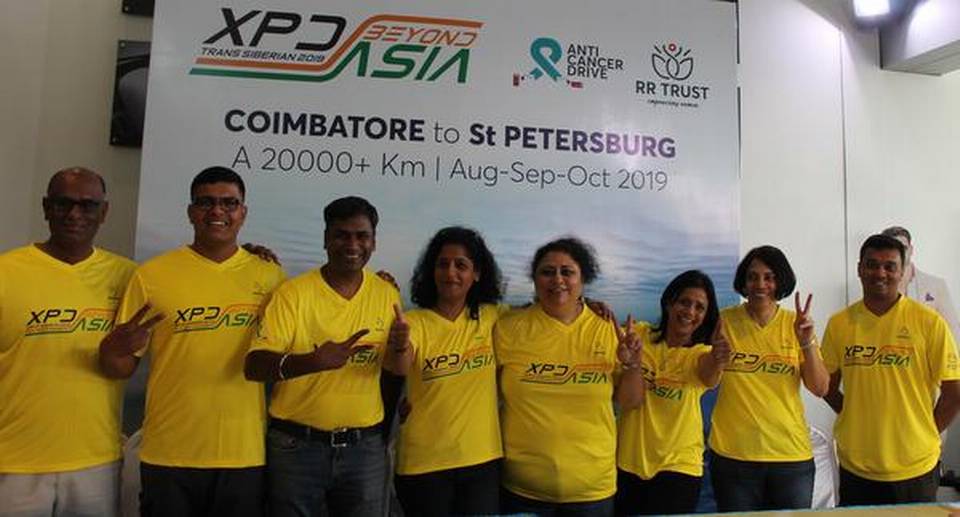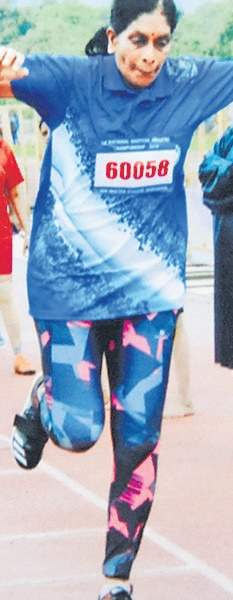Monthly Archives: August 2019
25
The long road to St Petersburgh
Meenakshi Sai Arvind and her team plan to cover 20, 000 km in two vehicles while spreading awareness about cervical cancer
In 2017, Meenakshi Sai undertook a road trip from Coimbatore to London. “That trip changed my life. I learnt so much from the different people I met on my way. My confidence increased manifold. I decided I wanted to do another road trip; so I researched for a year, set up route maps, marked the stop points, and so on. My brother Sanjay Subbian was the first to join me and four close friends, Sharath Madhav, Pradeep Yuvaraj, Sheila Verghis and Jomet Mani joined later. The only two people that I did not know from earlier are Madhuri Sapru and Anjana Kaul. They came forward seeing a post I had put up on Facebook inviting people to join.”
The eight of them are driving 20,000 km across four countries in two Tata Hexas upto St Petersburgh. It is not just a long drive, it has a purpose. XPD Trans-Siberian 2019: Beyond Asia, as the expedition is called, will spread awareness about cervical cancer.
“Cervical cancer is common among Indian women. It is also the only cancer that has preventive vaccines. We hope that the visibility that we receive will turn people’s attention towards this issue and bring in more sponsors to buy these vaccines for women from underprivileged background,” explains Meenakshi, who is also the managing trustee of RR Trust that organised the expedition.
The team was flagged off recently by social entrepreneur Arunachalam Muruganantham, athlete Gomathi Marimuthu, and and Indian Navy veteran Rajiv Choudhry. The journey will take them through Nepal, China and Russia. “We will drive through the day and rest at night. We plan to cover an average of 600 km a day. The highway between Vladivostok and Saint Petersburg, known as the Trans-Siberian highway, is the longest in the world. It is also dangerous as the place is sparingly populated and secluded. It stretches for a distance of 11,000 km.” The expedition is also taking along spare parts for the vehicle and fireproof jerry cans filled with fuel. They will come in handy especially in the long desolate stretches, especially in Siberia, that may not have fuel stations.
The only thing Meenakshi is worried about is Acute Mountain Sickness when they reach the Everest Base Camp. “The air will be thin there. We are carrying apparatus to keep a check on our oxygen levels, besides oxygen cylinders.
The team will also carry dehydrated vegetable biryani and tamarind rice. “We will eat it when we crave local food. I do not eat meat and finding vegetarian food in Russia can also be challenging. We are just being cautious.”
They plan to reach Saint Petersburg on September 27. “We will be flying back on October 1 and the cars will be shipped home.”
source: http://www.thehindu.com / The Hindu / Home> News> Cities> Chennai / by Susan Joe Philip / August 23rd, 2019
Subrahmanyan Chandrasekhar: A shining star of astrophysics
This great astrophysicist strongly influenced our understanding of stellar objects, black holes, white dwarfs and conducted remarkable work on Newton’s seminal work titled Philosophiae Naturalis Principia Mathematica.
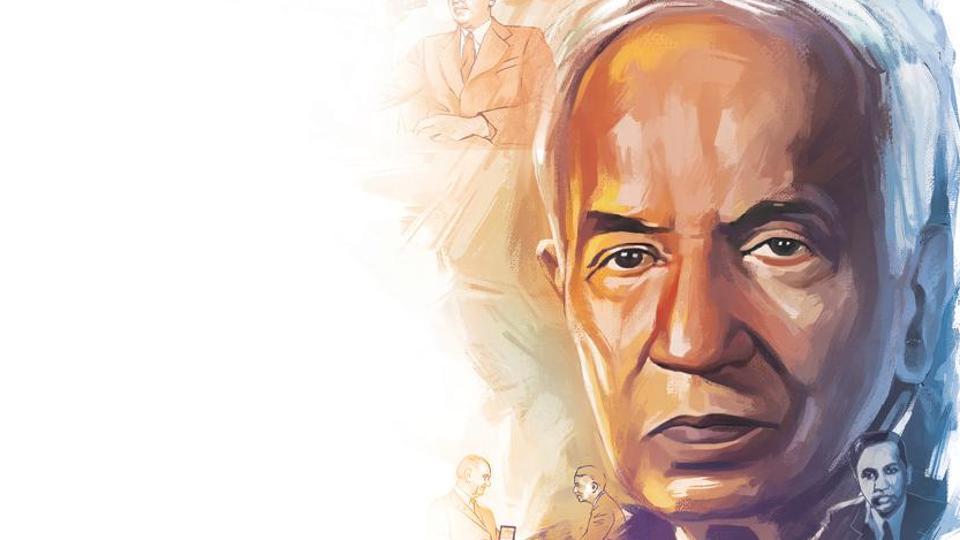
Chandra, as he was widely known, was born on October 19, 1910, in Lahore, to Tamil parents Sitalakshmi Balakrishnan and Chandrasekhara Subrahmanya Ayyar. His father was the deputy auditor general of the Northwestern Railway. The family moved to Allahabad in 1916 and settled in Madras in 1918.
Early life and education
Chandrasekhar was homeschooled till the age of 12. He then attended the Hindu High School at Triplicane, Madras and studied at Presidency College, Madras from 1925 to 1930. During this stint, he met Lalitha Doraiswamy and they got married in 1936.
A highlight of his college years was the publication of his paper, The Compton Scattering and the New Statistics. Successes such as this strengthened his determination to pursue a career in scientific research despite his father’s wish for him to join Indian Civil Service.
In 1930, Chandrasekhar was awarded a government scholarship to pursue graduation at the University of Cambridge, United Kingdom and he joined Trinity College. During this time, Chandra became enamoured with the subject of white dwarf stars. He explained how when stars run out of hydrogen, they become unstable and collapse in on themselves. But the most massive stars explode into a supernova and then collapse down into neutron stars, or black holes. He earned a PhD in 1933 and was elected to Prize Fellowship.
Career
In 1937, Chandrasekhar was appointed assistant professor in the University of Chicago – a position he continued in for his entire career spanning six decades. In 1947, he was appointed the distinguished service professor of theoretical astrophysics and, in 1985, became the professor emeritus.
As the editor of The Astrophysical Journal (1952-1971), he transformed the private publication into the National Journal of the American Astronomical Society. Apart from his work at the University, he also conducted research at NASA’s Laboratory for Astrophysics and Space Research.
In 1990, he began working on the detailed geometric arguments in Sir Isaac Newton’s famous work Philosophiae Naturalis Principia Mathematica, which is considered a significant work in the history of science. He died on August 21, 1995 of a heart attack.
Chandrasekhar Limit
He is best known for the discovery of the Chandrasekhar Limit, which he came up with as a student. Using this, he proved that there is a maximum mass which can be supported against gravity by the pressure made up of electrons and nuclei.
Awards, achievements
Chandra was honoured with the Padma Vibushan in 1968. In 1983, he was jointly awarded the Nobel Prize in Physics along with William A Fowler for work on the structure and evolution of stars. He was, however, upset that the citation mentioned only his earliest work and not his later ones. Chandrasekhar was awarded the Gold Medal of Royal Astronomical Society (1953), the Royal Medal (1962), and the Copley Medal (1984).
He has authored several books including – An Introduction to the Study of Stellar Structure (1939), Principles of Stellar Dynamics (1942), and Newton’s Principia for the Common Reader (1995).
Interesting Facts
1. He was the nephew of Sir CV Raman, who was a Nobel Prize recipient. Chandrasekhar became a US citizen in 1953, retired from the University of Chicago in 1980, and continued to be a researcher.
2. In 1979, NASA named the third of its four Great Observatories after Chandrasekhar. The Chandra X-ray Observatory was launched and deployed by Space Shuttle Columbia on July 23, 1999.
3. The Chandrasekhar number, a vital dimensionless number of magneto hydrodynamics, was named after him as were the asteroid 1958 Chandra and the Himalayan Chandra Telescope.
4. The Chandra Astrophysics Institute runs an initiative for high school students interested in astrophysics. They are mentored by scientists from MIT and sponsored by the Chandra Observatory.
5. His brother, S Balakrishnan, revealed that as a boy, Chandra had a deep desire to be like Isaac Newton. He used to go to the beach alone, and pray: ‘Oh God, may I be like Newton!’
Source: famouspeople.com; notablebiographies.com;Wikipedia
source: http://www.hindustantimes.com / Hindustan Times / Home> India> Inspiring Lives / by HT Correspondent, Hindustan Times, New Delhi / August 21st, 2019
380th Madras Day: Anna Nagar through the ages
From a village settlement to the commercial and residential hub it is today, locals trace the history of their neighbourhood.
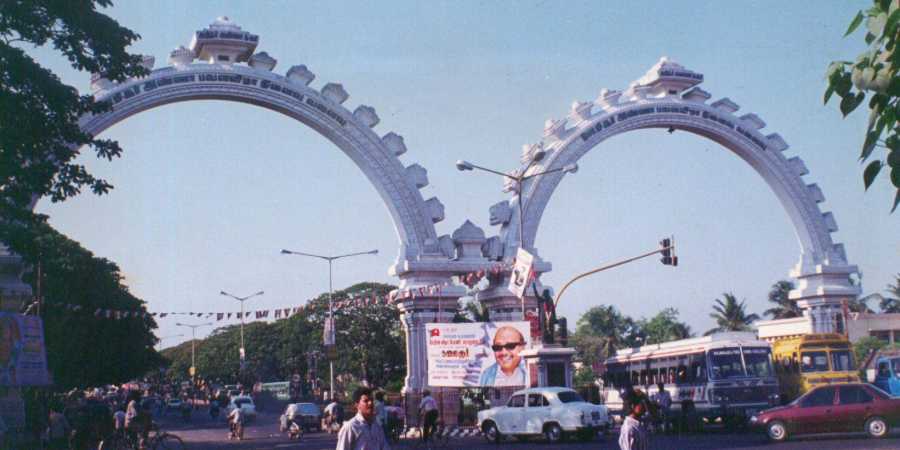
Chennai :
A scene from the 1971 film Rickshawkaran featuring the late actor-former chief minister of Tamil Nadu MG Ramachandran racing in a wagon on the roads of Anna Nagar is one that’s etched in the minds of Tamil film enthusiasts.
A closer look at the background, and one can spot the 51-year-old Anna Tower, one of the popular landmarks of Namma Chennai. While not much has changed about the magnificent edifice, the locality where it stands has seen exponential changes since its origin.
Since 2013, Nam Veedu, Nam Oor, Nam Kadhai, a social history group headed by architect-planner Thirupurasundari has been recording the evolution of Anna Nagar. As part of the Madras Week celebrations, the group curated a two-day exhibition featuring panels of the history and heritage of the neighbourhood, at Joy of Books.
Community initiative
“A few years ago, when preparations for Madras Day were in full swing, I noticed that no heritage events were being conducted in this part of the city. That’s when I decided to form this group to simply understand the locality. But, I didn’t want to constrain myself to just hosting walks or talks,” said Thirupurasundari, a resident of Shenoy Nagar.
The initiative spread like wildfire — thanks to community tabloids and the locality’s heritage crusaders. “When we began, we had a simple concept — to explore and document the history and heritage of the neighbourhood I was from. Six years later, it has grown and become a community initiative. There’s a sense of ownership among the residents about the area now,” she said.
A rural flavour
Before the 1950s, the village of Naduvakkarai had a truly rural flavour, with paddy fields and a serene river flowing nearby. Impressed by the true rural essence in the otherwise busy city as seen in Mount Road and Parrys, a few people settled down here to appreciate its silence and serenity, writes Thirupurasundari in a booklet released by the group in 2014.
People from other busy pockets of the city, including Mylapore and Triplicane, began migrating to Naduvakkarai in the 1940s and 50s. An illustrated depiction of this event by Akshayaa Selvaraj was on display. “When we interviewed the residents, some senior citizens even told us that they moved here because palm jaggery and first-class toddy were available here. Naduvakkarai had an abundance of palm trees,” said the architect.
Post-freedom rush
In the early 1960s, due to mushrooming of industrial pockets and rapid migration in the city, the housing board was formed to provide necessary housing facilities. In the wake, the West Madras Neighbourhood Scheme, which initiated subsidised development schemes and other structures was born. “The blueprint of contemporary Chennai was beginning to emerge. The idea of an integrated system of housing, meant for all classes possibly for the first time in the country, was initiated,” she said.
Guided through
Since the roads in Anna Nagar are designed based on matrix structure or similar to roads in developed countries in the western world, for many, hunting for the right lane and street is a task. Thirupurasundari said that between 1968 and the early 80s, Anna Nagar had guides who used to help people navigate. “These guides used to charge `1 or `2 and would guide you to whatever place you wanted to go to in the locality,” she said.
A historic fair
The 1968 Indian International Trade and Industries Fair, aimed to show India’s industrial development, changed the face of the neighbourhood. Brands like Voltas to Ovaltine had put up stalls as part of the fair. One of the main attractions was the Panchsheel tower (now called the Anna Tower) from which a panoramic view of the fair-site could be seen for a rupee or less.
After the fair’s success, more people were drawn towards the locality. “Interestingly, my amma and appa had attended the fair too. He was five and she was three years old. They both remember sitting in the Russian pavilion. This was the time when paper cups were emerging, and they both remember refusing to drink from a cup made of paper!” she said.
Interactive tour
We took a tour of the exhibition — from touch and feel exhibits depicting layouts of the State Housing Board’s West Madras Neighbourhood Scheme, panels of the 1968 Indian International Trade and Industries Fair, the evolution of Chandramoulishwarar temple, vintage images of the parabolic archway, screengrabs of film scenes that featured Anna Nagar, and other representational panels were on display. A drawing competition, quiz, storytelling session about Madras, display of household heritage items by Venkatraman Prabakaran and Sivagamasundari T, and early residents sharing anecdotes about the area were also part of the event.
“Talking to people who witnessed the stages of the neighbourhood’s development was essential. We have so far done 672 interviews of residents, senior citizens…they’ve all been kind and generous. Most of what you see here is a collation of all the information they gave us. From old photographs, maps and layouts of the area, they came forward to share whatever they know about Anna Nagar,” she shared.
source: http://www.newindianexpress.com / The New Indian Express / Home> Cities> Chennai / by Roshne Balasubramanian / Express News Service / August 22nd, 2019
App uses AI to detect banana pest, diseases
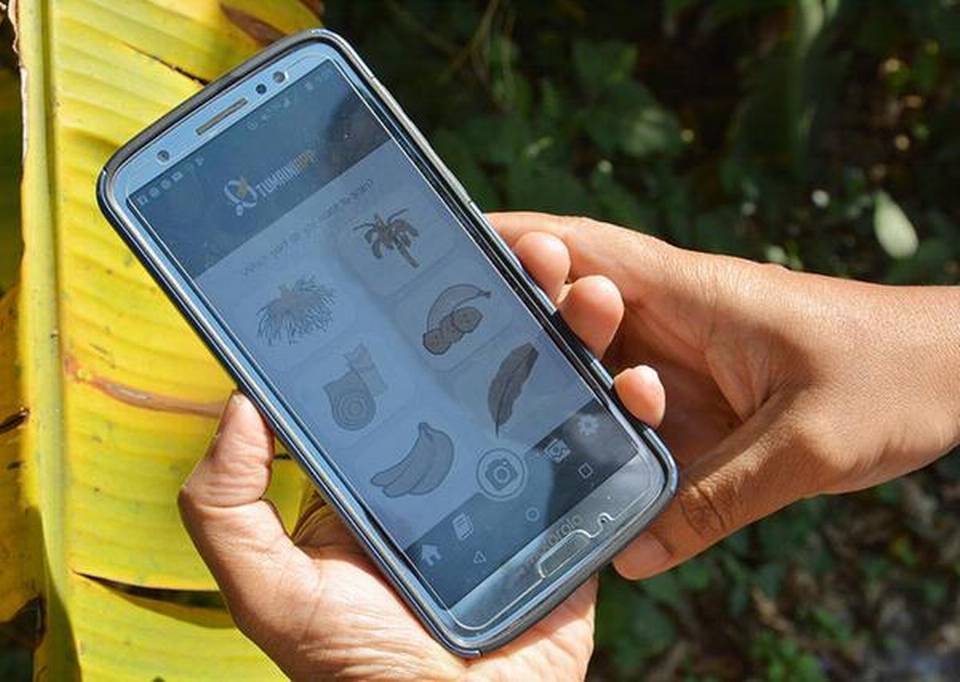
An App using this tool can diagnose the disease and give treatment options
Identifying diseases and pests on banana crops will now be just a click away. Researchers have developed a new artificial intelligence system (AI) which can look at photographs and tell what disease the plant has and also give recommendations and treatment options to the farmers. The results showed that the model was over 90% accuracy.
Training the network
The neural network was given about 20,000 images showing diseased and healthy plants. “Just like teaching a kid to tell an elephant from a horse, we taught the AI to identify leaf, root, fruit diseases and pests. Pictures from Uganda, Colombia, Congo and India were fed into the system for the training,” says Dr. Sivalingam Elayabalan from the Department of Biotechnology, Imayam Institute of Agriculture and Technology (IIAT), Trichy, Tamil Nadu. He is one of the authors of the study published in Plant Methods.
The tool is now incorporated into an App called Tumaini, meaning hope in Swahili, and being tested.
Expansion of scope
The team is planning to add more diseases based on regions and also make the App available in local languages. “When users take the photo, it gets uploaded to a global system for large-scale monitoring. Also, it is automatically GPS-tagged so we know what and where the problem is. We are also planning to incorporate high-resolution satellite monitoring to check the health of large fields,” explains Dr. Michael Gomez Selvaraj, from the International Center for Tropical Agriculture (CIAT), Colombia in an email to The Hindu. Dr. Selvaraj is the senior author of the paper. The App can detect symptoms on any part of the crop, and is even trained to read images of lower quality.
Major Indian diseases
The app is now being tested across many countries and when the confidence of 100% is reached it will be available for free download. “Yellow leaf spot and Fusarium wilt are the major fungal diseases in India and farmers spend a lot of money on fungicides. Apart from the fungal disease, the viral disease such as Banana Bunchy top virus is a big problem in hilly areas of Tamil Nadu, Kerala and Northeast region. The App can tell the farmers in advance bringing down the treatment costs,” says Dr. Elayabalan. “We are now testing the App in Tamil, and it will soon be available in Hindi and Malayalam. The National Research Centre for Banana (NRCB) and the Indian Council of Agricultural Research (ICAR) have shown interested in the App.”
source: http://www.thehindu.com / The Hindu / Home> Sci-Tech> Science / by Aswati Pachi / August 17th, 2019
IIT-Madras develops cells to be used in cancer research
The research is significant as stem cells are difficult to isolate and grow. Research is being conducted all over the world, to extract and culture CSCs for cancer understanding and drug development.
Chennai :
Researchers of the Indian Institute of Technology Madras (IITM) have found that subjecting cancer cells to microgravity, results in the formation of giant cancer cells with stem-cell characteristics, which can be used for cancer research and drug development, said a statement issued by the Institute.
The research was led by Professor Rama S Verma, Stem Cell and Molecular Biology Laboratory, Department of Biotechnology, IIT Madras. Speaking about the research, Verma said the stem cells obtained using micro. The research is significant as stem cells are difficult to isolate and grow. Research is being conducted all over the world, to extract and culture CSCs for cancer understanding and drug development. gravity can also be used to understand the nature of the cancer cells, their proliferation and cell death pathways, which in turn, can help in the identification of target zones for drug development.
He further added, “We have shown that simulated microgravity can be used for the development of stem cell structures for drug testing, instead of animal models. Cancer Stem Cells(CSC) are important in cancer research because they not only instigate the formation of tumour, but are also involved in recurrence of tumours after cancer treatment.”
The research is significant as stem cells are difficult to isolate and grow. Research is being conducted all over the world, to extract and culture CSCs for cancer understanding and drug development. “These stem cells can be used for cancer research and drug development,” said Verma.
source: http://www.newindianexpress.com / The New Indian Express / Home> Cities> Chennai / by Express News Service / August 21st. 2019
Innovative app fetches Chennai girls top spot in U.S. contest
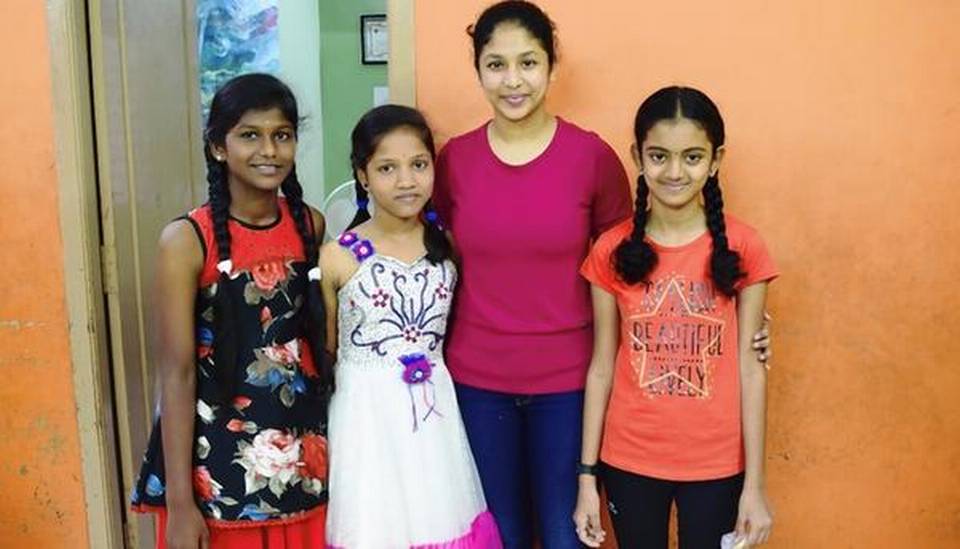
‘Baton’ designed to maximise the impact of initiatives started by interns in the field of social work.
‘Social Relay’, a team of three school girls from Chennai, bagged the first place at Technovation Girls organised in the United States of America by Technovation, a global not-for-profit organisation that focuses on technology education. The team won a prize money of $12,000.
The team members — Akshara Vasanth, a Class VI student of PSBB School K.K. Nagar, Ishwarya Kanagaraj, a Class VII student from the Panchayat Union Middle School Poothapedu and Stella Arokiasamy, a Class IX student of Our Angel Matriculation School — were mentored by Tanya Elizabeth Ken, a Class XI student of Kola Perumal Chetty Vaishnav School. Both Stella and Aishwarya stay at Paadhai, a home in the city for destitute children.
At the World Pitch 2019, the finals, Social Relay pitched their app ‘Baton’, which was designed to maximise the social impact of initiatives started by social work interns or students’ internships. “The app works around the idea of a relay race, where the baton is handed over and aims to hand over incomplete social work initiatives from one intern to another so that they are not affected by internships which last only for a limited time. It will bring together social workers, students, corporates, NGOs and volunteers,” the team said.
Dreaming big
Speaking from California, Akshara Vasanth said she was thrilled with her team’s win. “This is not just a great opportunity for me, but for girls from across the world. We are looking forward to develop our app further and take it across the country as well as the world,” she said.
The team from Chennai was among six from across the world in the junior division at the World Pitch, which was the final event of Technovation Girls, where they exhibited the functioning of their apps. Over 2,000 teams from 57 countries participated in the competition and six teams each were selected as finalists in the junior and senior division.
“Lack of a social worker empowerment tool is a problem across the world and the team believes that Baton is the solution, as it brings together key stakeholders for achieving social impact, while optimizing social work,” said Tanya, speaking from California.
“I hope more girls are inspired and encouraged to delve into technology and innovation,” she added.
The program encourages girls between the ages of 10 and 18 years from across the world to use technology and apply the skills needed to solve real life problems.
source: http://www.thehindu.com / The Hindu / Home> News> Cities> Chennai / by Staff Reporter / Chennai – August 19th, 2019
Health matters: This Chennai sexagenarian is invincible
Sprinting towards her dreams and knocking down stereotypes, T Rukmini Devi is yet to befriend retirement — her game is still on.
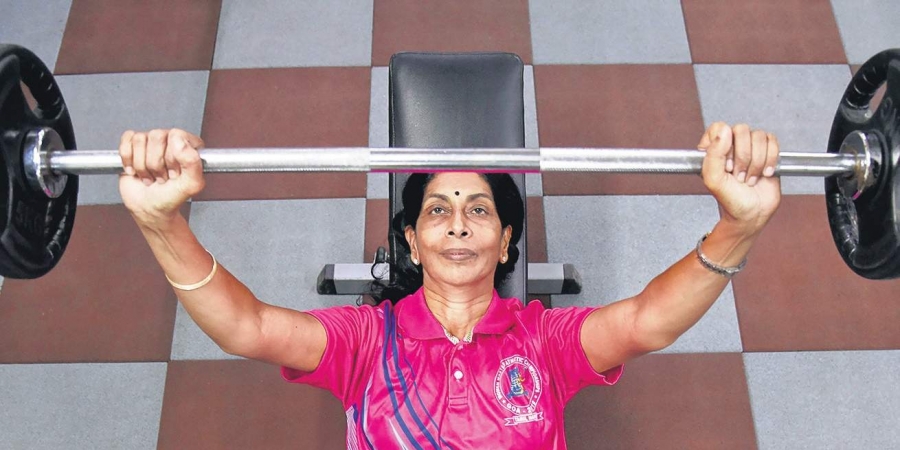
Chennai :
Training sessions at Jawaharlal Nehru outdoor stadium. Core strengthening at the gym. Badminton and table tennis for leisure. A toned physique, brisk gait and a sporty demeanour, T Rukmini Devi looks anything but 64. The sexagenarian’s daily schedule is packed with workout sessions, alongside other club roles. She is not hassled by her hectic routine. CE caught up with Rukmini after her morning practice to know what keeps her going.
“I took up sports out of my interest. My father served the military services back then. Our lifestyle was active, organised and disciplined. He brought me up as a bold girl. Right from inter-school competitions, parades, to international level competitions, I’ve taken part in all kinds of activities. After marriage, I had to take a break to focus on my children. Now I’m back after 15 years. That void is filled and I’m living my dream again,” said Rukmini who was born in Mumbai.
Rukmini moved to Chennai from Hyderabad in 1980 and started working with the Indian Overseas Bank (IOB). She retired as the assistant manager in the Public Relations Department four years back.
Aging while playing
She finished her schooling in Bengaluru and moved to Hyderabad for higher studies. “Nowadays, I take part in flag hoisting, we distribute sweets to underprivileged kids and spend our time at old age homes or Corporation schools,” said Rukmini, who lives with her husband Chandrakanthan and two daughters in T Nagar.
After completing her MSc in Physics from Osmania University, she joined the Indian Railways through sports quota and worked there for two years. She was part of the Indian Railways Basketball Team. Between 1974 and 1980, she represented and captained the Andhra Pradesh Basketball Team and the Andhra Pradesh Handball Team in the years 1978 and 1979. In 1982, she joined the Indian Overseas Bank. She headed the basketball and tennikoit team.
After a gap of 15 years, she represented India at the Veterans Athletics (now known as Masters Athletic Meet) in Thailand in 2008, Malaysia in 2009, Taipei in 2012 and Singapore in 2016. In the 2016 Masters Athletic Meet, she won a gold medal in the pole vault, a silver medal in the high jump and a bronze medal in the hammer throw. At the National Masters Athletic Championship held at Bengaluru in 2017 in the above 60 age category, Rukmini won a gold medal for the high jump, pole vault and 4×400 relay with a silver medal in the hammer throw and 4×100 relay.
The laurels continued at the nationals championship held at Guntur from February 6 to 10 where she won three gold medals in the above 60 age category for the high jump, hammer throw and pole vault. She has created a national record for pole vault covering a distance of 1.65 m with the previous record being only 1 m.
Second innings
Rukmini seems invincible at this point as she also won gold medals for the hammer throw and triple jump and a silver medal for triple jump at the first-ever Women’s Athletic Nationals held at Goa on June 29 and 30. Rukmini has received many awards at the club, district and international level. Recently, she was also honoured with Lifetime Achievement Award in sports by the All Indian Lioness Multiple and Lions Clubs.
“One needs the right exposure. I prefer working out on the field or dancing in my class any day over watching television. We get to meet people from different countries on international tours. Our fitness is nothing compared to their dedication. So I want to make the best of what’s available here, train people, learn, and achieve. I’m glad to see many women taking part in these competitions and bringing pride to our nation,” she said.
Passionate about dance from a young age, she recently joined the Athmalaya School of Dance for Elders. She is also being trained for badminton and table tennis for the veterans group. Rukmini is known to be passionate towards service to mankind. She enjoys singing and dancing in her spare time. She has also learned Kuchipudi from guru Rajasulochana and comperes for Doordarshan along with tournaments and meetings.
“My family motivates me. People can always find their second calling at any point in life. One needs to speak their mind to the children and set their priorities right. Never use taking care of grandchildren or retirement as an excuse. It will make you sluggish and invite unwanted thoughts. As parents, we need our independence too,” said Rukmini who is preparing for an Asian meet in December in Malaysia.
source: http://www.newindianexpress.com / The New Indian Express / Home> Cities> Chennai / by Vaishali Vijaykumar / Express News Service / August 17th, 2019
President’s medal for CRPF IGP T. Sekar
His distinguished service recognised
T. Sekar, Inspector-General of Police of CRPF’s Cobra School of Jungle Warfare Training in Khanapur in Belagavi, has been awarded the President’s police medal for distinguished service on the occasion of Independence Day.
Hailing from Thirumazhisai in Tamil Nadu, he joined CRPF in 1986 as Deputy Superintendent of Police.
He has served in crisis situations in Punjab, Jammu and Kashmir, Assam, Tripura, Manipur and Maharashtra. He has commanded Operational Range Gadchiroli (MH) and led and planned many Anti-Naxal operations. He has led various anti-terrorist operations in disturbed areas to curb terrorism and militancy. He has also served as an SPG officer from 1989 to 1998 on the security wing of VVIPs, including Prime Ministers and former Prime Ministers.
source: http://www.thehindu.com / The Hindu / Home> News> States> Karnataka / by Special Correspondent / Belagavi – August 15th, 2019
